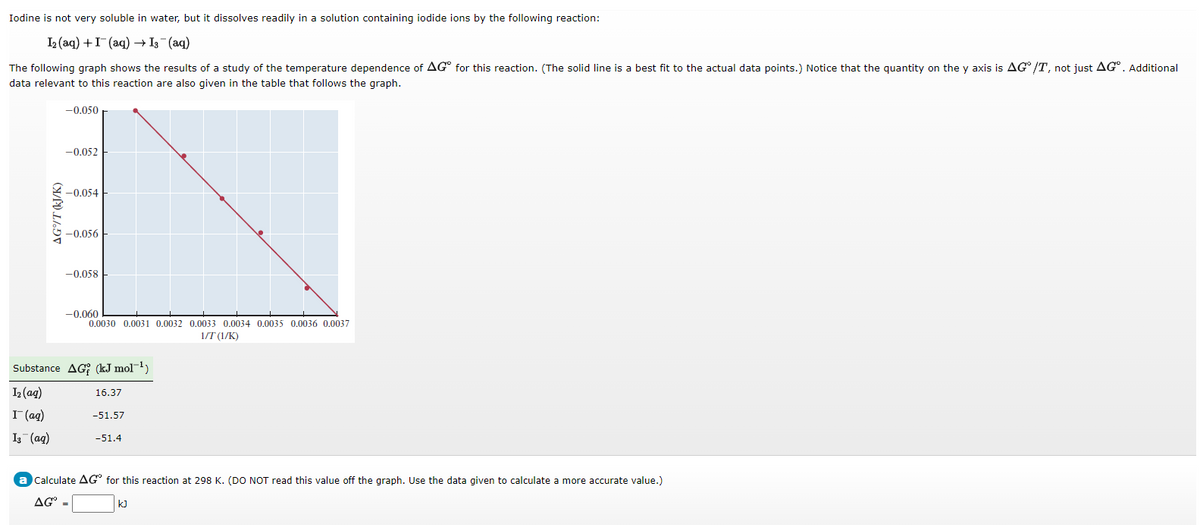-0.058 -0.060 0.0030 0.0031 0.0032 0.0033 0.0034 0.0035 0.0036 0.0037 1/T (1/K) Substance AG (kJ mol-¹) 1₂(aq) I (aq) Is (aq) 16.37 -51.57 -51.4 Calculate AG for this reaction at 298 K. (DO NOT read this value off the graph. Use the data given to calculate a more accurate value.) AG - kJ
-0.058 -0.060 0.0030 0.0031 0.0032 0.0033 0.0034 0.0035 0.0036 0.0037 1/T (1/K) Substance AG (kJ mol-¹) 1₂(aq) I (aq) Is (aq) 16.37 -51.57 -51.4 Calculate AG for this reaction at 298 K. (DO NOT read this value off the graph. Use the data given to calculate a more accurate value.) AG - kJ
Chemistry: The Molecular Science
5th Edition
ISBN:9781285199047
Author:John W. Moore, Conrad L. Stanitski
Publisher:John W. Moore, Conrad L. Stanitski
Chapter12: Chemical Equilibrium
Section: Chapter Questions
Problem 92QRT
Related questions
Question

Transcribed Image Text:Iodine is not very soluble in water, but it dissolves readily in a solution containing iodide ions by the following reaction:
I₂ (aq) + I¯ (aq) → 13(aq)
The following graph shows the results of a study of the temperature dependence of AG for this reaction. (The solid line is a best fit to the actual data points.) Notice that the quantity on the y axis is AG /T, not just AG. Additional
data relevant to this reaction are also given in the table that follows the graph.
AGOT (kJ/K)
-0.050
-0.052
-0.054
-0.056
-0.058
-0.060
0.0030 0.0031 0.0032 0.0033 0.0034 0.0035 0.0036 0.0037
1/T (1/K)
Substance AG (kJ mol-¹)
1₂ (aq)
16.37
I (aq)
13 (aq)
-51.57
-51.4
a Calculate AG for this reaction at 298 K. (DO NOT read this value off the graph. Use the data given to calculate a more accurate value.)
AG =
kJ
Expert Solution
This question has been solved!
Explore an expertly crafted, step-by-step solution for a thorough understanding of key concepts.
Step by step
Solved in 2 steps with 1 images

Knowledge Booster
Learn more about
Need a deep-dive on the concept behind this application? Look no further. Learn more about this topic, chemistry and related others by exploring similar questions and additional content below.Recommended textbooks for you

Chemistry: The Molecular Science
Chemistry
ISBN:
9781285199047
Author:
John W. Moore, Conrad L. Stanitski
Publisher:
Cengage Learning

Chemistry: Principles and Reactions
Chemistry
ISBN:
9781305079373
Author:
William L. Masterton, Cecile N. Hurley
Publisher:
Cengage Learning

Chemistry & Chemical Reactivity
Chemistry
ISBN:
9781133949640
Author:
John C. Kotz, Paul M. Treichel, John Townsend, David Treichel
Publisher:
Cengage Learning

Chemistry: The Molecular Science
Chemistry
ISBN:
9781285199047
Author:
John W. Moore, Conrad L. Stanitski
Publisher:
Cengage Learning

Chemistry: Principles and Reactions
Chemistry
ISBN:
9781305079373
Author:
William L. Masterton, Cecile N. Hurley
Publisher:
Cengage Learning

Chemistry & Chemical Reactivity
Chemistry
ISBN:
9781133949640
Author:
John C. Kotz, Paul M. Treichel, John Townsend, David Treichel
Publisher:
Cengage Learning

Chemistry & Chemical Reactivity
Chemistry
ISBN:
9781337399074
Author:
John C. Kotz, Paul M. Treichel, John Townsend, David Treichel
Publisher:
Cengage Learning

Chemistry for Engineering Students
Chemistry
ISBN:
9781337398909
Author:
Lawrence S. Brown, Tom Holme
Publisher:
Cengage Learning

General Chemistry - Standalone book (MindTap Cour…
Chemistry
ISBN:
9781305580343
Author:
Steven D. Gammon, Ebbing, Darrell Ebbing, Steven D., Darrell; Gammon, Darrell Ebbing; Steven D. Gammon, Darrell D.; Gammon, Ebbing; Steven D. Gammon; Darrell
Publisher:
Cengage Learning